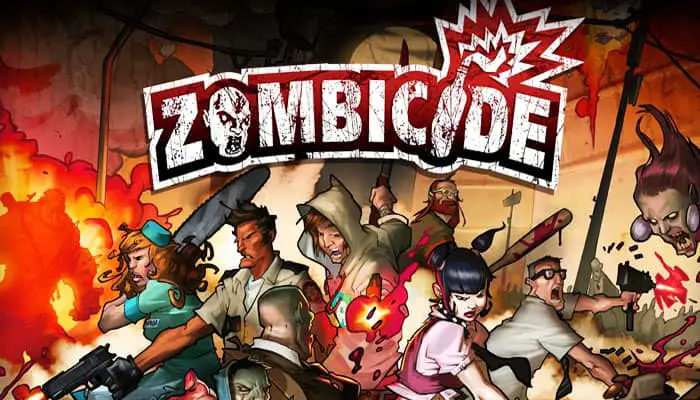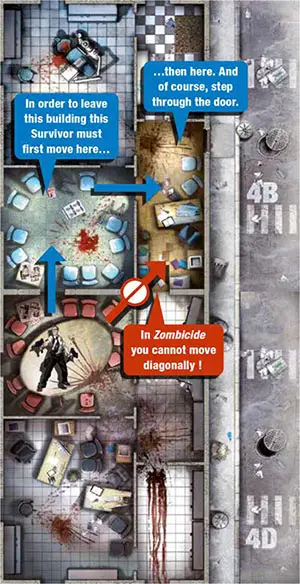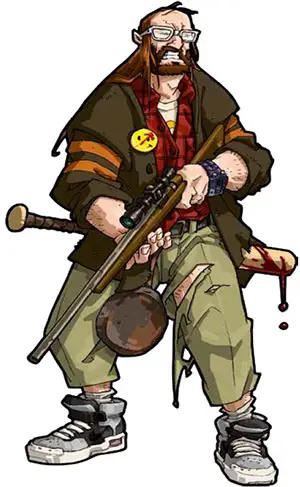
Zombicide is a cooperative game where players face hordes of Zombies controlled by the game itself. Each player controls one, two, three, or four Survivors of a Zombie infection. The goal is simply to complete the Mission objectives and live to see another day.
The good news: Zombies are slow, stupid, and predictable. The bad news: there are a lot of Zombies!
Survivors use whatever they can get their hands on to kill Zombies. If they find bigger weapons, they can kill even more Zombies!
You can trade equipment, give and receive (or ignore) advice, and even sacrifice yourself to save the girl! Only through co-operation, however, can you achieve the Mission objectives and survive. Killing Zombies is fun, but you will also need to rescue other Survivors, clean out infested areas, find food and weapons, take a ride through a ghost town, and much more.
After experiencing Zombicide, your gaming group will be the ultimate zombie killing team in town!
Components

- 9 double-sided tiles
- 6 survivor miniatures
- 40 walker miniatures
- 8 fatty miniatures
- 16 runner miniatures
- 1 abomination miniature
- 42 zombie cards
- 62 equipment cards
- 6 wound cards
- 6 dice
- 6 character sheets
- 10 Objective Tokens
- 18 Noise Tokens
- 12 Door Tokens
- 1 First Player
- 24 Skill Counters
- 6 Experience Trackers
Setup
-
Choose a Mission.
-
Place the tiles.
-
Place the doors, the cars, and Objectives.
-
Put aside the pimpmobile cards (Evil Twins and Ma's Shotgun), Molotov, Pan, and Wounded cards. Also keep a single Fire Axe, Crowbar, and Pistol card.
-
Shuffle the Zombie cards into one deck and the Equipment cards into another, then place them face down close to the board.
-
Each player chooses his Survivors based on the number of players:
- 1 player: 4 Survivors.
- 2 players: 3 Survivors per player.
- 3 players: 2 Survivors per player.
- 4 to 6 players: 1 Survivor per player.
-
Place the miniatures representing the chosen Survivors on the starting area as indicated by the Mission.
-
On each Survivor's Identity Card, place an experience tracker on the first square in the blue area of the Danger Bar, and place a Skill counter on the first corresponding Skill.
-
Randomly deal the starting equipment: a Fire Axe, Crowbar, Pistol, and enough Pans so that each Survivor gets one card. If a Survivor's starting Skill lists any starting weapons, he receives those cards now, independent of the starting Equipment that's just been distributed.
Example: Phil is dealt one of the random starting Equipment cards and gets the pistol! He then takes the weapon listed on his Identity Card from the Equipment deck: another pistol!
-
Decide who will be the first player, and give him or her the "first player" token. Zombicide is a cooperative game, so do not pick randomly!
 Game Elements
Game Elements
Useful Definitions
Actor
A Survivor or Zombie.
Zone
Inside a building, a Zone is a room. On the street, a Zone is the area between two pedestrian crossings and the walls of buildings along the street. A single Zone may extend over two tiles or even four tiles.
Line of Sight
How do I know if a Zombie sees me or if I see it?
On the streets, Actors see in straight lines that run parallel to the edges of the board. Actors cannot see diagonally. Their line of sight covers as many Zones as the line can pass through before reaching a wall or the edge of the board.
Inside a building, an Actor sees into all Zones that share an opening with the Zone the Actor currently occupies. If there is an opening, the walls do not block line of sight between two Zones. An Actor's line of sight, however, is limited to the distance of one Zone.
Note: If the Survivor is looking out into the street, or from the street into a building, the line of sight can go through any number of street Zones in a straight line, but only one Zone inside the building.

Movement
Actors can move from one Zone to the next, as long as the first Zone shares at least one edge with the destination Zone. Corners do not count; this means Actors cannot make diagonal movements.
On streets, the movement from one Zone to another has no restrictions. However, Actors must go through a door to move from a building to the street and vice versa.
Inside a building, Actors may move from one Zone to another as long as these Zones are linked by an opening. The position of the miniature in the Zone and the layout of the walls do not matter, as long as the Zones share an opening.

Noise
Firing a gun or smashing through a door makes noise, and noise attracts Zombies. Each Action that opens a door with a noisy weapon or attacks with a noisy weapon (see the "Noisy Weapons" callout) produces a Noise token.
Place this token in the Zone where the Survivor resolved the Action. A single Action can only produce a single Noise token, no matter how many dice are rolled, how many hits are obtained, or if Dual weapons are used.
Each Survivor miniature also counts as a Noise token. Yes, they just can't seem to stay quiet! Noise tokens are always removed from the board after the Zombies' Phase.
Example: Ned opens a door with a Fire Axe. It's a noisy way to open a door. This produces a Noise token. He then attacks a Zombie in his Zone, knocking it down after a couple of whacks. The Fire Axe is a silent killing weapon, so this action produces no noise. There remain two "noises" in this Zone, however: the token produced by opening the door and Ned's miniature itself.
In another Zone, Amy executes three Ranged Combat Actions with her two Dual Sub MGs. Although she rolled six dice, she gets only three Noise tokens in her Zone, one for each Ranged Action. The tokens remain on the square where she produced them; they don't follow Amy when she moves.
Noisy Weapons
Many Equipment cards, such as the Fire Axe, Crowbar, or Chainsaw, allow you to open doors as well as eliminate Zombies".

Equipment that allows you to open doors has this symbol.

Equipment that allows you to kill Zombies has this symbol.
The association of these symbols with one of the following symbols determines whether the equipment produces a Noise token when you use it to open a door or eliminate a Zombie:

Equipment that has this symbol produces a Noise token.

Equipment which has this symbol is silent and does not produce a Noise token.

Example 1: The Fire Axe can open doors and kill Zombies.
It produces a Noise token when used to open a door.
When you use it as Melee weapon to put down a Zombie, it does not produce a Noise token.

Example 2: The Chainsaw can also open doors and kill Zombies.
It produces a Noise token when used to open a door AND when you use it as Melee weapon to make Zombie slices!

Experience, Danger Level, And Skills
For each Zombie killed, a Survivor gains an experience point and moves up a notch on his Danger Bar. Some Mission objectives provide more experience, as does eliminating the Abomination.
There are four Danger Levels: Blue, Yellow, Orange, and Red. These represent everything from a light drizzle of Zombies to a flash flood. (You really don't want to see what happens at the Red level..).
On each Danger Level, the Survivor gains one new Skill to help him on his mission (see Skills, page 18). Skills add to each other across Danger Levels: at the Red Level, your Survivor will have four Skills.
When a Survivor reaches 7 experience points, his Danger Level moves to Yellow, and he obtains a fourth Action. He may use this Action immediately and then every turn thereafter; in other words, he now has a permanent additional Action.
When a Survivor gets 19 experience points, the Orange Danger Level becomes active, and he can choose one of the two Skills indicated on his Identity Card.
At 43 experience points, the Survivor reaches the Red Danger Level and obtains one Skill from among the three available at this Level.
This experience has a side effect, however. When you draw a Zombie card to spawn a Zone, read the line that corresponds to the Survivor with the highest Danger Level!

Inventory
Each Survivor can carry up to five pieces of Equipment but can only have two equipped and ready to use (one in each hand) at any given time.
While all weapons must be in a hand slot in order to use them (whether to attack or to open a door), other items, such as the Goalie Mask, Flashlight and Plenty of Ammo cards, are always in effect, even while in the reserve slots.
If your Survivor has more than five Equipment cards, discard cards until he has five.
The Zombies
There are four types of Zombies:
Walker

It stinks, it's nasty, and it's slow. Eliminating a Walker provides 1 experience point.
Fatty

Big, bloated, and tough, these Zombies are hard to put down. Weapons dealing only 1 Damage can't hurt them...at all. Y
ou need a 2 Damage weapon to kill them. Each Fatty spawns with two Walkers alongside him, except when its group is splitting (see Zombies' Phase, page 12). Killing a Fatty provides 1 experience point.
Abomination

Mutated beyond recognition, the Abomination is the Survivors' worst nightmare. Only weapons dealing 3 Damage or more can kill this monster. A well-aimed Molotov will do the trick, as it
kills everything in its target Zone. Luckily, there's only one Abomination on the board at any given time. If a second Abomination is drawn, replace it with a Fatty and its two Walkers.
The Abomination spawns alone (possibly having eaten its Walker fellows). Killing an Abomination provides 5 experience points.
Runner

Amped up for some reason, these guys move twice as fast as Walkers. Each Runner has two Actions per activation, while all other Zombies only have one. Eliminating a Runner provides 1 experience point.

Game Play
Zombicide is played over a series of game turns, which go as follows:
I. Players' Phase
The player with the "first player" token takes his turn, activating his Survivors one at a time, in the order of his choice. Each Survivor can initially perform three Actions per turn, though Skills may allow him to perform extra Actions as the game progresses.
The Survivor uses his Actions to kill Zombies, move around the map, and perform other tasks to accomplish the various Mission objectives.
Once a player has activated all his Survivors, the player to his left takes his turn, activating his Survivors in the same manner.
When all the players have completed their turns, the Players' Phase ends.
The Players' Phase is explained in depth here.
II. Zombies' Phase
All of the Zombies on the board activate and spend one Action either attacking a Survivor next to them or, if they have nobody to attack, moving toward the Survivors they see or, if they don't see any, toward the noisiest Zone.
Runners get two Actions, so they can attack twice, attack and move, move and attack, or move twice.
Once all Zombies have performed their Actions, new Zombies appear in all of the active Spawn Zones on the board.
The Zombies' Phase is explained in depth here.
III. End Phase
All Noise tokens are removed from the board, and the first player hands the "first player" token to the player on his left. Another game turn then begins.
End of the Game
The game is lost when all Survivors have been gruesomely killed and eliminated from the game.
The game is won immediately when all of the Mission objectives have been accomplished.
Zombicide is a cooperative game, so all players win if the Mission objectives are fulfilled, even if all of a player's Survivors have selflessly given their lives in heroic sacrifice.
A stupid death or willful suicide, on the other hand, can hardly be considered all that victorious.
Continue Reading


